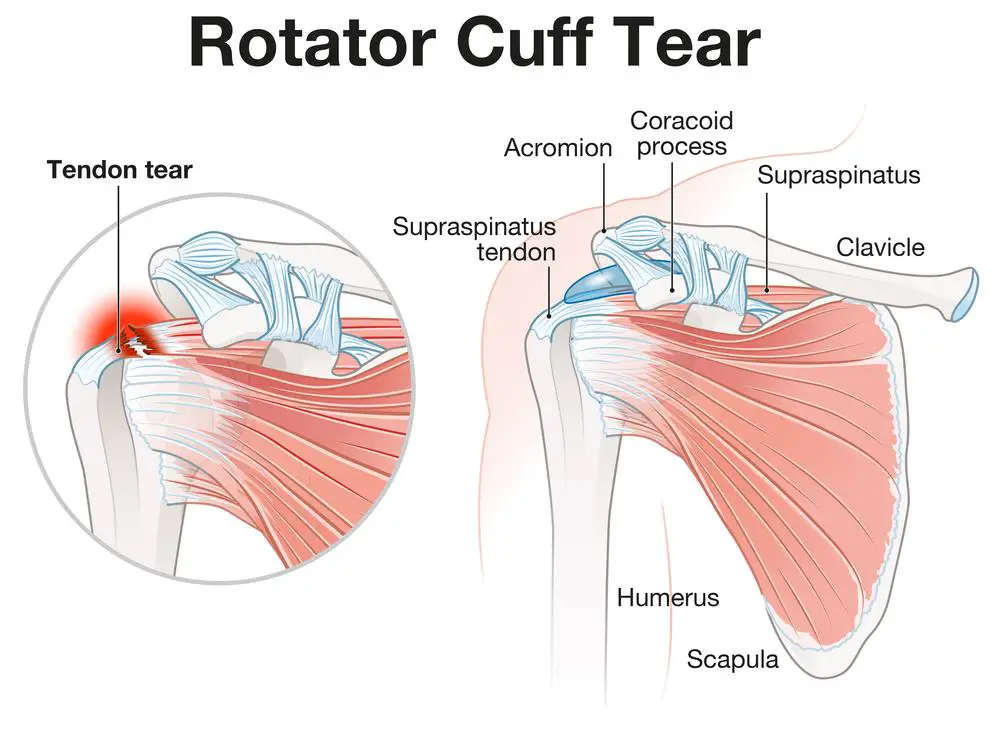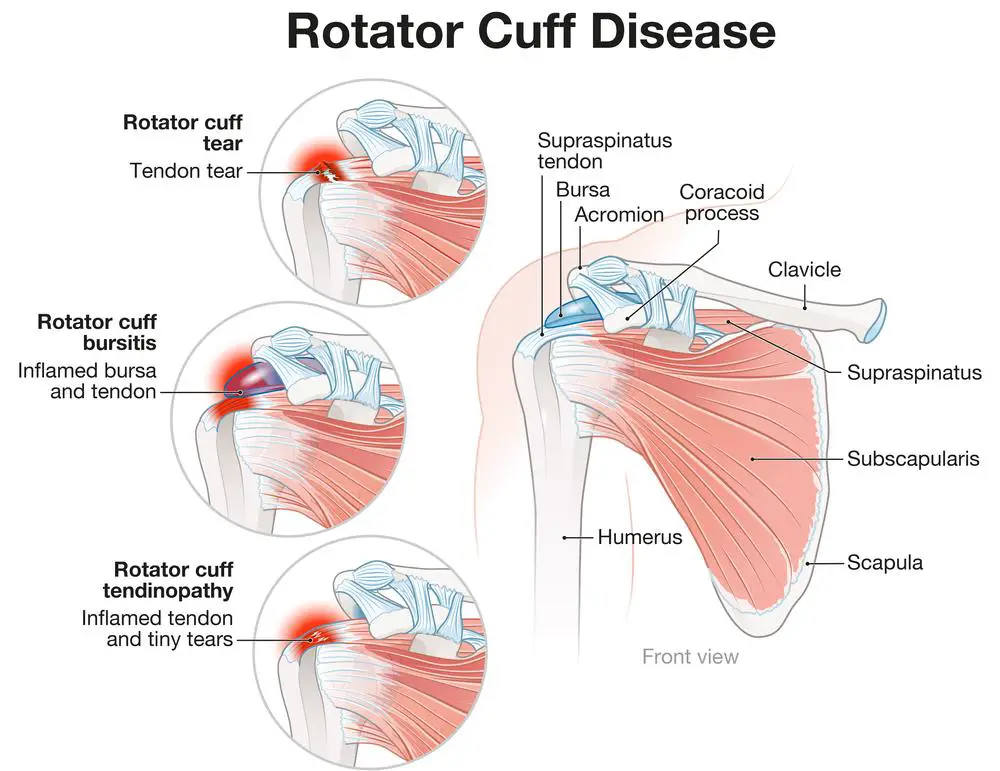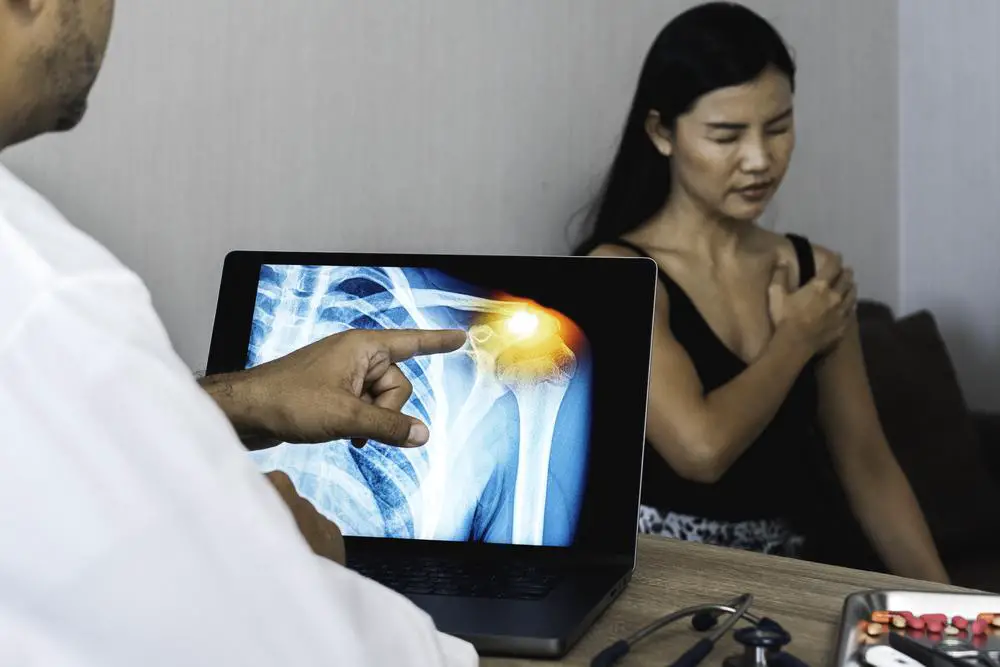As a BetterHelp affiliate, we receive compensation from BetterHelp if you purchase products or services through the links provided
Sleeping after rotator cuff surgery can be challenging, as your body needs to adjust and heal properly. Rotator cuff surgery aims to repair damage to the tendons and muscles in your shoulder and is typically done using arthroscopic techniques. After the procedure, it is crucial to follow your doctor’s recommendations to ensure a smooth recovery and minimize complications.
During the early stages of recovery, you may struggle with sleep due to pain, discomfort, or the need to keep your operated shoulder immobilized. Finding the right sleeping position and using appropriate supports, such as pillows or a shoulder sling, can help you achieve a restful night’s sleep while protecting your healing shoulder. It’s also essential to take prescribed pain medications and adhere to recommended rehabilitation exercises as part of your recovery process.
Key Takeaways
- Adjusting to sleep after rotator cuff surgery is essential for proper healing and recovery.
- Properly supporting the operated shoulder can alleviate pain and promote restful sleep
- Following your doctor’s advice, including pain management and rehabilitation exercises, is crucial for optimal recovery

Understanding Rotator Cuff Surgery
Rotator cuff surgery is a procedure performed to repair damaged tendons in your shoulder joint. Tendons are the muscular connective tissues that attach your rotator cuff muscles to the bones in your shoulder. When you experience a rotator cuff tear, it can be quite painful and limit your range of motion. Fortunately, surgery is an option to help you regain strength and movement.
There are two main types of rotator cuff surgery: arthroscopic surgery and open surgery. Arthroscopic surgery is less invasive, as a surgeon uses a small camera called an arthroscope to view the shoulder joint and make tiny incisions to repair the torn tendon. This surgery typically has a faster recovery time and less postoperative pain.
On the other hand, open surgery may be necessary for larger or more complex tears. The surgeon makes a larger incision and has more direct access to the shoulder joint. While this method may result in a longer recovery time, it can be more effective for some patients.
If you need rotator cuff surgery, your doctor will consider factors like the severity of the tear, your overall health, and your desired level of activity when determining which type of surgery is best for your situation.
After surgery, you’ll undergo a recovery process that includes pain management, rest, and physical therapy to help get your shoulder back to normal. Although the recovery timeline may vary depending on factors such as the type of surgery and your healing process, most people generally return to an average activity level within six to nine months.
Sleeping can be challenging after rotator cuff surgery, but by following specific strategies like using pillows for support or sleeping on an incline, you can make the process more comfortable. Remember always to follow your doctor’s advice and be patient, as your shoulder will gradually heal with time.
 Why Is Sleeping a Challenge After Surgery?
Why Is Sleeping a Challenge After Surgery?
Sleeping after rotator cuff surgery can be quite a challenge due to the different factors influencing both the physical and emotional aspects of recovery. Addressing these issues will help facilitate a more comfortable and restful sleep.
Firstly, shoulder pain is an unavoidable part of the healing process. Surgical repairs often involve the manipulation of injured tissues, which can cause swelling and pressure, leading to discomfort and pain in your arm. This pain is heightened at night, making it difficult to find a comfortable sleeping position. As you age, your body also takes more time to heal, adding to the challenge of sleeping soundly.
Moreover, reduced mobility after surgery contributes to sleeping challenges. Your arm, confined in a sling, limits the positions you can comfortably sleep in. Additionally, the possibility of accidentally moving your injured arm while turning during sleep can be a source of anxiety and stress, hindering a good night’s rest.
Here are some tips to alleviate these difficulties:
- Elevate your arm using pillows, which will minimize swelling and alleviate pressure on the shoulder while sleeping
- Use a reclining chair or stack pillows on your bed to create a semi-upright position, as this helps to reduce strain on the surgical area
- Avoid caffeine and heavy meals before bedtime, as they may worsen sleep quality.
- Manage stress by practicing relaxation techniques, such as deep breathing exercises or meditation
- Consistently follow pain-management instructions provided by your doctor, to minimize shoulder pain throughout the night
Remember, taking the time and extra care to ensure a comfortable sleep will benefit your healing process and help you return to normal activities sooner.
 Preparation for Post-Surgery Sleep
Preparation for Post-Surgery Sleep
Recovering from rotator cuff surgery can be challenging, especially when getting a good night’s sleep. Don’t worry; we’re here to help you prepare for post-surgery sleep with valuable tips and tricks.
First of all, it’s essential to follow your doctor’s advice. They’ll provide specific guidelines for your recovery, including how to use a shoulder sling. Wear the sling as instructed, as it helps support the shoulder and prevents pain when moving.
Next up, think about sleeping in an upright position. Post-surgery, it’s often more comfortable to sleep in a reclining chair or propping up your mattress with pillows. An incline of about 45 degrees helps alleviate pressure on your arm and shoulder.
To further support your arm, place a pillow under it while you sleep. Doing so will provide additional stability and prevent any strain that may cause pain. Your physical therapist may also give you some positioning guidelines during your appointment.
Another consideration when preparing for sleep is the support from your mattress or recliner. Ensure it offers adequate comfort and cushioning for your healing shoulder. If needed, investing in a mattress topper or a specialized recliner can be beneficial.
Lastly, don’t be afraid to ask for help from your friends and family. Having someone assist you with getting up, adjusting your pillows, or even refilling your water bottle can greatly help during your recovery. Remember, it’s essential to prioritize your comfort and support to ensure you get proper rest during this time.
By following these recommendations, you’ll be better prepared for post-surgery sleep, ensuring a more comfortable healing process. Good luck, and happy healing!

Recovery Process and Timeline
After undergoing rotator cuff surgery, it’s essential to understand the recovery process and timeline. The goal is to regain strength, range of motion, and full shoulder functionality. Be patient, as full recovery often takes six to nine months, with some cases extending up to 14 months. Remember, recovery time varies depending on factors such as the size and severity of the tear, surgical outcome, and your commitment to rehabilitation.
During the initial weeks, it’s crucial to protect your healing muscles, wear a sling, and avoid strenuous movements that might trigger pain and delay recovery. Keeping your shoulder immobilized is crucial in allowing the rotator cuff repair to heal correctly. It’s usually recommended to have someone help you with daily tasks while wearing a sling.
Throughout your recovery journey, you’ll be actively participating in physical therapy. These sessions help you regain your range of motion, reduce stiffness, and strengthen your shoulder muscles. It’s essential to follow your doctor’s instructions and do prescribed exercises diligently. Here are a few tips to help you during the rehab process:
- Be consistent: Stick to your therapy schedule and exercises as your therapist recommends.
- Communicate: Keep an open line of communication with your healthcare team. Share any concerns or symptoms you might experience.
- Be patient: Understand that the recovery process takes time, and resist the urge to compare your progress with others.
As you progress through your rehab sessions, your physical therapist will introduce new exercises and movements to enhance your shoulder strength further. These exercises will focus on various aspects of recovery, such as stretching, mobility, and strengthening exercises to help you regain the normal function of your shoulder.
Remember, potential complications may extend your recovery time. Delayed healing, infection, or stiffening of the shoulder joint can impact your progress, so consult your doctor if you notice any new or worsening symptoms. Your healthcare team is there to guide and support your recovery journey every step of the way.
The road to full recovery after a rotator cuff surgery can be a lengthy one. Still, by following your doctor’s instructions and staying committed to physical therapy, you’ll gradually regain your shoulder function and return to your normal activities.
Physical Therapy and Exercises
After rotator cuff surgery, it’s essential to work with a physical therapist to regain your shoulder’s strength, range of motion, and functionality. Let’s discuss the role of physical therapy and exercises in your recovery.
In the initial two to eight weeks after surgery, you will focus on limiting movement and wearing a sling. Your physical therapist will help you with passive stretching exercises to maintain and improve your range of motion. Don’t push too hard; instead, be gentle and patient with yourself during this stage.
Once you’ve progressed with passive stretching and your doctor gives the green light, you’ll transition to an active stretching stage. In this phase, the physical therapist will guide you through exercises that require your power, like arm circles and pendulum swings. Remember, slow and steady wins the race; be diligent about performing these stretches and keep track of your progress.
As you continue your recovery, you’ll begin working on initial strengthening exercises. These will help you rebuild the muscles around your shoulder and might involve resistance bands or light weights. Always follow your physical therapist’s recommendations on the type, frequency, and intensity of exercises to ensure proper healing.
Finally, you’ll move on to weight-bearing exercises. These will help fortify your rotator cuff and improve your shoulder’s overall stability. Exercises such as the shoulder press, lateral raises, and external rotations will become part of your routine at this stage. Just remember to listen to your body and communicate with your physical therapist, as they will help you adjust the workout accordingly.
Throughout the entire physical therapy process, be sure to keep the following tips in mind:
- Always consult with your doctor and physical therapist before starting a new exercise.
- Pay attention to technique, as proper form is crucial for effective healing.
- Stay consistent with your therapy schedule and keep track of your progress.
By faithfully sticking to your physical therapy exercises, you’ll be well on your way to a strong, functional shoulder and a successful recovery. Remember, your journey is unique—trust your instincts and rely on the guidance of your healthcare team to get you back on track.
Taking Care of the Surgical Site
After your rotator cuff surgery, it’s essential to take proper care of the surgical site to ensure a smooth recovery. By following these guidelines, you’ll minimize the risk of infection, inflammation, and other complications.
First and foremost, make sure to attend all your doctor appointments. Your doctor will monitor your progress and advise you on managing your recovery.
Keep a close eye on your incision. It’s normal to see some redness and swelling after surgery. However, if you notice increased redness, swelling, heat, or discharge, it could be a sign of infection. Don’t hesitate to contact your doctor if you observe any of these symptoms.
To prevent infection, remember to:
- Keep the incision area clean and dry. Follow your doctor’s instructions on when and how to change the dressing.
- Refrain from putting any ointments or creams on the incision site unless your doctor has recommended them.
- Avoid submerging the incision in water, such as in a bathtub, until your doctor tells you it’s safe.
In the event of a fever, contact your doctor immediately. A fever can indicate an infection, and it’s essential to address it promptly.
Although it may be uncomfortable at times, make an effort to keep your surgical site slightly elevated during sleep. This position helps reduce inflammation and improves blood flow to the area, promoting faster healing.
Taking care of the surgical site involves more than just wound care. Don’t forget to:
- Ice the area regularly, especially in the first few days after surgery. This will help alleviate pain and inflammation.
- Wear your sling as instructed by your doctor. The sling supports your shoulder and prevents unnecessary movement that could damage the healing tissue.
- Gradually incorporate gentle shoulder exercises as approved by your doctor or physical therapist. These exercises will aid in regaining strength and range of motion.
In summary, diligent care of your surgical site plays a crucial role in your rotator cuff surgery recovery. Stay attentive to signs of infection, inflammation, or complications, and maintain regular communication with your doctor. Proper care will pave the way to a successful and speedy recovery.
Pain Management Techniques
We understand that recovering from rotator cuff surgery can be a challenging experience, especially when getting a good night’s sleep. In this section, we’ll discuss some pain management techniques that can help you sleep more comfortably.
First and foremost, follow your doctor’s recommendations for pain relief. They might prescribe pain medication to help you cope with the pain, so be sure to use them as prescribed. It’s essential to stay in close communication with your healthcare provider to adjust the medication if necessary.
Cold therapy can be a highly effective way to manage pain after surgery. Applying an ice pack to the affected shoulder for around 20 minutes at a time, a few times a day can reduce inflammation and ease discomfort. Be sure to wrap the ice pack in a towel or cloth to protect your skin from direct contact with the cold.
Over-the-counter pain relievers and anti-inflammatory medications can also provide relief. Consult your doctor before taking any over-the-counter medications, as they can guide you on the appropriate type and dosage. Common medications include ibuprofen, naproxen, and acetaminophen, but it’s crucial to follow your doctor’s advice.
Some strategies to help you manage pain while sleeping include:
- Elevating the affected arm using pillow support
- Sleeping on an incline to reduce pressure on your shoulder
- Wearing a shoulder sling at night as advised by your doctor
Remember that patience and persistence are essential during the recovery process. Follow your doctor’s recommendations, practice rehabilitation exercises, and maintain a positive attitude. With time, these pain management techniques should help you sleep more comfortably and speed up your recovery.
Regaining Daily Activities
After rotator cuff surgery, it’s crucial to take steps toward regaining your everyday activities while remembering that your arm needs time to heal. Let’s get started on some tips for a smoother recovery process.
First and foremost, give your arm the rest it needs. Avoid overuse and wearing it out too early, which could lead to a torn tendon or further damage. Your body needs time to recover, so don’t rush this process.
Now, let’s talk about mobility. As you progress in your recovery, it’s important to gradually increase your arm’s range of motion through physical therapy and light exercises. Make sure to follow your therapist’s guidelines, as they’ll lead you along the path to regaining your arm’s strength and flexibility.
- Stay patient and consistent with rehabilitation. Physical therapy plays an essential role in your recovery, and it may include passive and active motion exercises. Remember, you must work steadily with your therapist and remain consistent with your sessions to get the best results.
- Avoid heavy lifting and high-impact activities. In the beginning, stick to light and low-impact activities and slowly work your way up. It’s essential to avoid anything that may put too much strain on your recovering arm.
As you regain mobility and strengthen your arm, you can slowly reintroduce daily activities that involve the affected arm. This could range from simple tasks like brushing teeth or picking up small objects to demanding actions like carrying groceries or lifting weights.
In conclusion, remember to be patient with yourself and follow your therapist’s guidance throughout the process. As you progress, you’ll find that you can gradually reestablish your daily routine and reintegrate the activities you love. Keep an open mind, and before you know it, your arm will be back in action, ready to tackle life’s daily challenges.
When to Consult Your Doctor
It’s essential to monitor your progress and healing after rotator cuff surgery closely. Sometimes, complications or symptoms might arise that warrant a visit to your doctor, orthopedic surgeon, or specialist. Here are some instances when you should make an appointment:
- Experiencing new or worsening symptoms: If your pain, numbness, or stiffness increases or new symptoms develop after surgery, it’s vital to discuss them with your doctor.
- Difficulty moving or using your shoulder: Although shoulder movement is limited after rotator cuff surgery, any drastic degeneration in your range of motion should be brought to your doctor’s attention.
- Changes in the appearance of your surgical site: In case you notice redness, swelling, or discharge from your incision, make sure to consult your doctor, as these could be signs of a potential infection or complication.
As a proactive measure, maintain an open line of communication with your specialist during your recovery. In addition to properly following their advice for rehabilitation, keep them informed of any concerns that may arise. Here are some tips for making the most of your appointments:
- List your concerns and questions: Write down any questions or observations that may arise during your recovery, making it easier for you to address them during your next consultation.
- Follow a strict schedule: Adhere to a strict appointment schedule, as your doctor recommends, to ensure timely evaluation and progress tracking.
Remember, rotator cuff surgeries often involve repairing tendons that have suffered significant damage due to repetitive movement. Proper communication and prompt appointments are crucial for your overall recovery and well-being. So, don’t hesitate to consult your doctor if something doesn’t feel right.
Conclusion
After your rotator cuff surgery, it’s crucial to focus on proper sleep positioning and pain management throughout the recovery process. Sleeping plays a huge role in healing, and finding comfortable positions can make all the difference in your experience.
Keep in mind that sleeping on your back with your affected arm elevated will help prevent putting pressure on the shoulder. Additionally, sleeping on an incline can further reduce any discomfort. Wearing your sling at night is also essential, as it helps prevent accidental movement that could cause harm to the recovering area.
Don’t underestimate the power of physical therapy in your recovery journey. Engaging in regular sessions will not only aid in regaining your shoulder strength but also improve your range of motion. Always follow your physical therapist’s guidelines and recommendations to ensure a safe and effective recovery process.
Remember to be gentle with yourself during this period. Your body has gone through a significant surgical procedure, and it will take time to heal completely. Aim to be consistent with your pain management strategies, such as taking anti-inflammatory medications as prescribed and icing regularly. Ultimately, your patience and determination will pay off as you regain your normal shoulder function and enjoy a successful recovery from rotator cuff surgery.
Frequently Asked Questions

What is the best position for sleeping after rotator cuff surgery?
After a rotator cuff surgery, it’s essential to find a comfortable sleeping position that doesn’t strain your shoulder. Many experts recommend sleeping in a reclined position, either in a recliner chair or by propping yourself up with pillows. This position helps prevent rolling onto the affected shoulder while sleeping, allowing it to heal without additional stress.
How long should I sleep upright following the surgery?
The duration for sleeping upright after rotator cuff surgery varies for each individual. Typically, it is recommended for at least a few weeks post-surgery. It’s crucial to follow your surgeon’s advice and pay attention to your body’s comfort and healing progress during this time.
When can I sleep on the non-operated side post-surgery?
You can usually start sleeping on your non-operated side a few weeks after surgery. However, it’s essential to get your doctor’s clearance before transitioning to this position. Using a pillow between your arms for added support can help alleviate any discomfort while you sleep.
How to use a wedge pillow for sleeping after the surgery?
A wedge pillow can be an excellent tool for improving sleep quality after rotator cuff surgery. Place the pillow on your bed, with the higher end positioned towards the headboard. This will elevate your upper body and keep your shoulders comfortable while you sleep. You can also adjust the angle of the wedge to find the most comfortable position for you.
When is it safe to sleep without a sling after rotator cuff surgery?
Sleeping without a sling after surgery is typically safe once your doctor gives you the go-ahead. This decision is based on factors like your healing progress and comfort level. It’s crucial to continue wearing the sling, according to your doctor’s instructions, until you receive the clearance to sleep without it.
Can I sleep on the operated shoulder after some time?
It’s generally not recommended to sleep on the operated shoulder for a prolonged period after surgery. However, as you recover and regain strength, you can gradually introduce sleeping on the affected side. Always consult your doctor before significantly changing your sleeping position, and listen to your body’s cues for comfort and healing.
- How to Transform a Home’s Patio Space into a Relaxing Space - March 23, 2025
- 5 Strategies to Use a Cell Phone to Help Manage Your Stress - March 23, 2025
- 4 Ways to Use Measurements to Create a Relaxing Sleep Space - March 23, 2025
This site contains affiliate links to products. We will receive a commission for purchases made through these links.


 Why Is Sleeping a Challenge After Surgery?
Why Is Sleeping a Challenge After Surgery? Preparation for Post-Surgery Sleep
Preparation for Post-Surgery Sleep
